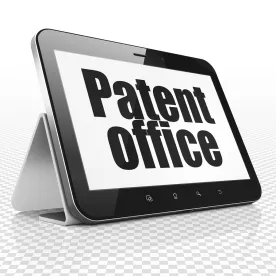Introduction
This article is the fourth in a five-part series. Each of these articles relates to the state of machine-learning patentability in the United States during 2019. Each of these articles describe one case in which the PTAB reversed an Examiner’s Section-101 rejection of a machine-learning-based patent application’s claims. The first article of this series described the USPTO’s 2019 Revised Patent Subject Matter Eligibility Guidance (2019 PEG), which was issued on January 7, 2019. The 2019 PEG changed the analysis provided by Examiners in rejecting patents under Section 101[1] of the patent laws, and by the PTAB in reviewing appeals from these Examiner rejections. The previous article of this series described methods for overcoming 101 rejections where the PTAB has found that an abstract idea is “recited.” This article describes another case where the PTAB applied the 2019 PEG to a machine-learning-based patent and concluded that the Examiner was wrong.
Case 4: Appeal 2018-004485[2] (Decided April 1, 2019)
This case involves the PTAB reversing the Examiner’s Section 101 rejections of claims of the 14/789,857 patent application. This application relates to
maintaining a database of user profiles based, respectively, on user interaction with third-party systems. . . . ‘identify potential items of interest to the unique user’ such as news articles related to the data collection. . . . the predicted items of interest ‘may include articles identified as having person names and/or company names determined to match contact records associated with the unique user profile.’
The Examiner contended that the claims are directed to the “organizing human activity” and “mental processes” categories of abstract ideas:
[The claims] recite an abstract idea of ‘comparing new and stored information and using rules to identify options.’ . . . a fundamental economic practice of ‘a system that allows organizations to more fully realize and leverage the relationships of its members.’ . . . recite ‘procedures that can – and are – done by attorneys working on multiple cases who keep such links mentally or in a paper file.’”
The Applicant made several arguments in its appeal. The first argument was “the subject matter of the claimed invention is far removed from the concepts of [the three categories of abstract ideas].” The argument that the claims are “far removed” is similar to the argument that the alleged abstract ideas are “integrated” (Step 2A, Prong 2). Additionally, the claims being “far removed” is similar to the “significantly more” language of an “inventive concept” argument (Step 2B). However, based on context, it seems like the Applicant was arguing that the claimed subject matter is so different than the abstract idea categories that the abstract idea categories are not recited (Step 2A Prong 1).
The second argument the Applicant made was “the Examiner has overgeneralized the claim in characterizing it.” This argument might be directed to Step 2A where the 2019 PEG provides “[i]t is critical that examiners consider the claim as a whole when evaluating whether the judicial exception is meaningfully limited by integration into a practical application of the exception.” This argument might also be directed to the Examiner’s application of both prongs of Step 2A generally, rather than being directed to a specific clause in the 2019 PEG. Regardless the relation of this argument to the 2019 PEG, the PTAB had emphasized this argument in other 2019 cases.[3]
The third argument the Applicant made was that the “claims are analogous in various respects to earlier claims found eligible by our reviewing court.” Before the 2019 PEG, the Examiners’ reasoning for 101 rejections was based on analogies to Federal Circuit cases. Now, with the implementation of the 2019 PEG, the Examiners do not generally cite cases to explain the reasoning for 101 rejections. The Frequently Asked Questions on the 2019 PEG[4] (2019 FAQ) answered the Examiner’s question of “Can I still cite a court decision in my Office actions to support the identification of the subject matter recited in the claim language as an abstract idea?” with
Under the 2019 PEG, you should cite to one of the enumerated groupings of abstract ideas. You may cite a court decision to support identification of the subject matter recited in the claim language as an abstract idea, but the identification of the subject matter recited in the claim language as an abstract idea should be consistent with the 2019 PEG.
Accordingly, citing case law may still be a meaningful way of corroborating the arguments under the 2019 PEG structure. Also, the 2019 PEG cannot restrict the issuance of patents beyond the scope provided by Title 35 of the United States Code, as interpreted by the Supreme Court and the Federal Circuit. So, case-law arguments may be especially helpful in situations where application of the 2019 PEG seems inconsistent with case law.
Additionally, though it might not be suggested for Examiners to make case-law arguments for 101 rejections, it seems that case-law arguments by Applicants is still anticipated by the USPTO. In the 2019 FAQ, the USPTO answered an Examiner’s question, regarding an Applicant’s use of a case in an argument against a 101 rejection, by stating that
The examiner should indicate that the 2019 PEG is now applicable, and point out which of the enumerated groupings of abstract ideas applies to the claimed concept previously identified as an abstract idea. The 2019 PEG is consistent with the Supreme Court and Federal Circuit subject matter eligibility decisions.[5] Thus, an examiner should consider and address applicant’s arguments with respect to any specific case in the manner that an examiner would consider and address a specific case cited by an applicant in response to a rejection on another patentability ground (e.g., 35 U.S.C. § 103 or non-statutory double patenting).
The fourth argument that the Applicant made was that the invention “improves the functioning of a computer . . . by enabling a computer to identify and predict items of interest based on intelligent and active monitoring of user activity based on data stored in a unique user profile.” This argument comes directly from the first Step 2A, Prong 2 example, relating to improving the functioning of a computer. This example, and this argument, come from DDR Holdings – a Federal Circuit Case decided in December 2014 that has been a common argument type for overcoming 101 rejections.
The fifth argument the Applicant made was that the “invention enables a computer to do something that goes beyond human capabilities from a computational standpoint.” While the fourth argument is that the method improved a computer, this fifth argument is that the method could only be performed on a computer. This fifth argument is similar to an example provided in Step 2A Prong 2 of the 2019 PEG: “an additional element implements a judicial exception with, or uses a judicial exception in conjunction with, a particular machine or manufacture that is integral to the claim.”
The sixth argument the Applicant made was that the invention is an improvement over existing methods. This argument, though seemingly directed to Section 102 and Section 103 issues of novelty and non-obviousness, may actually be directed at the Step 2B argument of “inventive concept.” While Sections 102 and 103 require determining if there is an improvement over existing methods, Step 2B requires determining which elements contribute significantly to that improvement. Step 2B essentially draws a line between situations where the abstract idea is “extra-solution activity,” and situations where the additional elements are “extra-solution activity.” If the inventive aspects of a claim are significantly attributable to non-abstract elements of a claim, then – under Step 2B – the claim will be deemed to be subject-matter eligible, irrespective of the inclusion of the abstract ideas in the other elements. Additionally, the argument that there is innovation can be relevant at Step 2A Prong 2 in determining whether the “additional element reflects an improvement in the functioning of a computer, or an improvement to other technology or technical field.”
The seventh and final argument the Applicant made was that the claimed invention “is directed to novel subject matter that could not be replicated by a human performing mental steps [or using pen and paper].” This argument is directed to the “mental processes” category of abstract ideas (Step 2A Prong 1).
In its analysis, the PTAB agreed with the Applicant that the 101 rejection should be reversed as not reciting an abstract idea. Beginning with the second category of abstract idea, it quickly concluded that this was “not a type of ‘method of organizing human activity’ that is abstract.” The PTAB listed the examples provided by the 2019 PEG for this category of abstract idea, and concluded that none of them apply.
Then, indirectly addressing the Applicant’s first two arguments, the PTAB found that the Examiner “improperly overgeneralizes the claim,” and attempts to reject the claim outside the three enumerated categories of abstract ideas, which “is not a valid basis for determining the claims are directed to an abstract idea.” Elaborating on this, the PTAB further explained that “courts must be careful to avoid oversimplifying the claims by looking at them generally and failing to account for the specific requirements of the claims.” Additionally, the PTAB explained that the Examiner’s “characterization was formulated at too high a level of abstraction which did not correlate well with the express language of independent claim 1.”
Next, indirectly addressing the Applicant’s seventh argument, relating to the “mental processes” category of abstract ideas, the PTAB found that there is no “indication this concept is a purely mental process, as it describes the use of a database which stores user profiles as well as the use of those user profiles and collected data to predict items of interest.” Furthermore, the PTAB stated, the “recited steps, under their broadest reasonable interpretation, ‘cannot practically be performed in the mind.’ Most of the recited limitations relate to data processing steps involving the transmission and gathering of data between several different systems.” This reasoning seems to indicate that utilizing multiple systems (e.g., multiple computers), utilizing databases, or performing “prediction” steps, make it more likely that the claims do not to recite a mental process. As explained in the second article of this series, the fact that a patent application provides that the method is performed on a computer (and not performed in a human mind) should not be the sole reason for concluding that the method is not a mental process; however, this may be used to corroborative other evidence. In this case, the PTAB may have been describing the computer components incidentally in attempting to describe the complexity of the method; or may have been describing them to corroborate the evidence of complexity, thereby indicating that this method can only practically be performed on a computer.
Conclusion
This case illustrates:
(1) the method of identifying potential items of interest based on contact records was held to not be an abstract idea, in this context;
(2) several arguments that an Applicant may make in an appeal at the PTAB;
(3) that an Applicant may argue that the Examiner has over-generalized a claim in characterizing it; and
(4) the recitation or “several different systems” may make it less likely that a method is a mental process.
Additionally, in this case, the Applicant presented seven arguments at the PTAB, none of which were directly and expressly addressed. The PTAB only addressed the Applicant’s arguments indirectly or impliedly. The Applicant’s arguments, notably, were not provided in the step-and-prong structure provided by the 2019 PEG, and did not use the express language that was used in the 2019 PEG. This appeal was successful for the Applicant – and it is difficult to argue with success – but it still seems that the Applicant’s arguments may have been stronger, or at least more directly and expressly addressed by the PTAB, had they been in the same argument structure that the PTAB is directed to use (i.e., had they been in the format provided by the 2019 PEG).
The next article will build on this background, and will provide a different example of how the PTAB approaches reversing Examiner 101-rejections of machine-learning patents under the 2019 PEG. Stay tuned for the analysis and lessons of the next case, which includes overcoming a rejection to claims that were determined to recite both “abstract ideas” and “natural phenomena.”
FOOTNOTES
[1] 35 U.S.C. § 101.
[2] https://e-foia.uspto.gov/Foia/RetrievePdf?system=BPAI&flNm=fd2018004485-04-01-2019-1.
[3] “The Supreme Court has long recognized that all inventions, at some level, embody or apply laws of nature, natural phenomena, and abstract ideas and, thus, we must ‘tread carefully in construing this exclusionary principle lest it swallow all of patent law.’ . . . we must neither overgeneralize the claim nor overemphasize limitations that might recite a natural law or an abstract idea dissected from the whole.” Appeal 2017-005993, p. 15 (Citing Alice).
[4] Frequently Asked Questions (FAQs) on the 2019 Revised Patent Subject Matter Eligibility Guidance (“2019 PEG”) https://www.uspto.gov/sites/default/files/documents/faqs_on_2019peg_20190107.pdf.
[5] As noted in a footnote earlier in this article, the 2019 PEG is not the same as the USPTO’s prior practice of analogizing Federal Circuit decisions, and – because the standard is different – it may lead to different results. However, the USPTO would be correct in saying that the application of judicial exceptions under the 2019 PEG cannot be broader than under the Federal Circuit decisions; and where inconsistencies may result in a broader application (if there is ever such a situation), the Federal Circuit case law, and not the 2019 PEG, should prevail.





 />i
/>i


